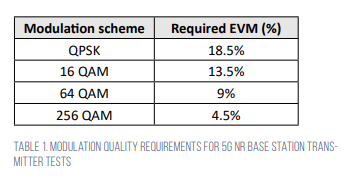Pave the way for next wireless breakthroughs
The pace of wireless innovation is accelerating to enable faster, more responsive, and more reliable connections worldwide.
This article originally appeared in the September'22 magazine issue of Electronic Specifier Design – see ES's Magazine Archives for more featured publications.
The wireless communications industry is ready for significant technology changes across multiple systems. While cellular communication is transitioning from 4G to 5G to enable extreme data throughputs, satellite communications providers are building networks in space to provide high-speed communications from anywhere in the world.
Wireless engineers look for breakthrough technologies to maximise system throughput, robust links, and data handling capabilities. The key technology components of the wireless system physical layer are wider bandwidths, higher-order modulation schemes, and multi-antenna techniques in wireless systems.
Wider signal bandwidths
Standard development organisations are looking for wider bandwidths at higher frequency bands because of the limited spectrum allocation. For example, 5G New Radio (NR) Release 15 specifies frequency range 2 (FR2) from 24.25GHz to 52.6GHz and a maximum channel bandwidth of 400MHz. Release 16 introduces to unlicensed frequency band in the 5GHz and 6GHz frequency ranges. By the middle of 2022, 3GPP Release 17 will extend the spectrum range up to 71GHz for unlicensed bands.
Satellite communications provide connectivity for a variety of television, phone, broadband internet services, and military communications. Satellites operate in many frequency bands, from the L to the Ka band. The International Telecommunication Union (ITU) allocates the 71 to 76GHz/81 to 86GHz segment of the W band to satellite services.
These frequency segments are of increasing interest to commercial satellite operators for wider bandwidths. On June 30, 2021, a satellite with a W-band radio transmitter successfully launched; more commercial projects in the W band are in the not-so-distant future.
Millimetre-wave frequency bands provide more available bandwidths. Wide bandwidths enable high-throughput data and low latency, but wider bandwidths also introduce more noise that degrades system performance.
Wireless engineers need to manage the noise problem for wideband communications. In addition to creating more system noise, wider bandwidths at higher frequency bands introduce other design and test challenges such as path loss, frequency responses, and phase noise.
Higher-order modulation schemes
Higher-order modulation schemes achieve faster data rates without increasing signal bandwidth and require closer symbols that are more sensitive to noise. Devices require better modulation quality as the modulation density increases. Table 1 shows the error vector magnitude (EVM) requirements for 5G NR base stations defined in 3GPP release 16 technical specification 38.141. Under consideration is the adoption of 1,024 QAM for 3GPP, which requires tighter design and test margins.
Both wider signal bandwidths and higher-order modulation schemes increase throughput. However, more bandwidth may not mean more system capacity. You must consider the signal-to-noise ratio (SNR) in the communication system. Proper SNR is critical to maintaining communication links. Wider bandwidths introduce more noise into the system, and higher-order modulation schemes are more susceptible to noise. You will need to transmit a high-power signal without distortion and reduce system noise to sustain the communication links. To test your designs, an accurate characterisation of each component and subsystem is required.
Multi-antenna techniques
Most wireless systems, whether in commercial applications or aerospace and defence, use multiple antennas techniques at the receiver, transmitter, or both to improve overall system performance. These techniques include spatial diversity, spatial multiplexing, and beamforming.
Engineers use multi-antenna techniques to achieve diversity, multiplexing, or antenna gains. Through these gains, wireless systems can increase a receiver’s data throughput and SNR. For example, 5G NR uses eight spatial streams for FR1 to improve spectral efficiency without increasing signal bandwidth.
As a result, 3GPP defines performance tests with multiple spatial streams for 5G NR base stations in Technical Specification (TS) 38.141-1. The tests require up to two transmitter antennas and eight receiver antennas, and each test case applies specific propagation conditions, correlation matrix, and SNR.
Compared with IEEE 802.11ax, the next-generation Wi-Fi standard, IEEE 802.11be (Wi-Fi 7), provides twice the signal bandwidth, 16 spatial streams, and quadruples the density of a modulation scheme. These together provide data rates up to 40Gbps. Table 2 illustrates the significant changes in the IEEE 802.11 physical layer.
Testing multi-antenna systems that use spatial diversity, spatial multiplexing, and multiple antenna arrays requires a test system capable of providing multichannel signals with stable phase relationships between them. However, a commercial signal generator has an independent synthesiser to upconvert an intermediate frequency (IF) signal to an RF signal.
A test system must provide precise timing synchronisation between channels to simulate the multichannel test signals. The phase between test signals must be coherent and controllable.
Summary
Next-generation wireless communication systems such as 5G, satellite, and Wi-Fi require higher frequencies, wider bandwidths, more complex modulation, and multi-antenna designs.
This will enable you to face new design and test challenges, including increased test complexity, measurement uncertainty, excessive path loss, and noise, that impact device performance.
To overcome these challenges requires a scalable test solution that enables higher frequency coverage, wider bandwidths, and multichannel applications with ease and accuracy.
A fully integrated, calibrated, and synchronised solution enables you to reduce test complexity and achieve faster, repeatable, and accurate results.












